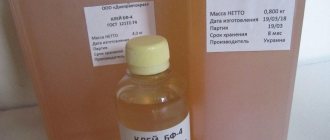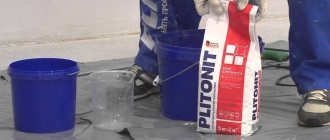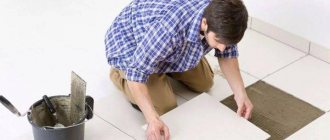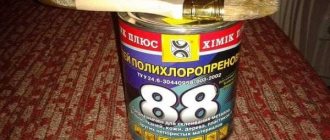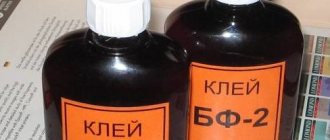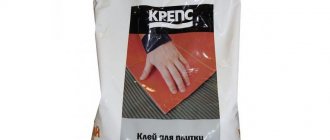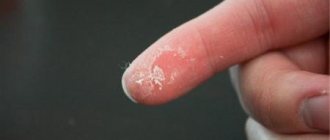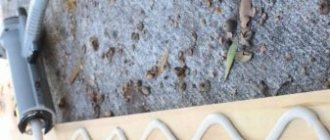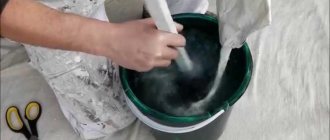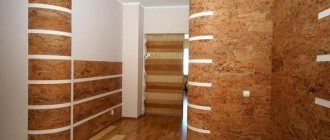Description and features
Poxipol is a two-component adhesive produced in two tubes. The first contains epoxy resin, and the second contains trimethylamine hardener. The latter is necessary so that the main component dries quickly. Poxipol is different in that when stored in tubes, the characteristics of the product do not change for decades. The features of this glue include the following:
- increased adhesion;
- the volume of glue after drying does not change (any amount can be applied);
- the duration of the complete drying period depends on the ambient temperature;
- glue is used for application to horizontal and vertical surfaces.
After hardening, the joint can be sanded, sanded, or threaded in this area. The characteristics of the glue do not change under such influence. There is no need to press the joints to harden. The glue dries completely within 24 hours, provided there is no vibration.
Advantages and disadvantages of "Poxipol"
The popularity of this brand of glue is due to its excellent adhesive properties. The seam is durable and does not collapse over time. The advantages of "Poxipol" are:
- preservation of the volume of the seam after drying, the possibility of applying an adhesive layer of any thickness;
- the use of glue on any materials (even those of different structure and density), no damage or corrosion when applied to most types of plastic;
- water resistance, oil resistance, scratch resistance;
- possibility of application to vertical and horizontal substrates using continuous and spot methods;
- ease of mixing and ease of application;
- quick setting and short time until complete curing;
- Possibility of use for interior and exterior work;
- absence of solvents in the composition, possibility of use in residential premises, children's institutions;
- absence of traces, stains, drips after drying;
- availability for sale in almost all hardware and construction stores;
- simplicity and clarity of instructions for use.
The disadvantages of Poxipol glue include its low tensile strength. Therefore, you should not use glue in conditions where parts are subject to vibration, other movement, deformation, or high mechanical loads. The quality of gluing decreases if the surface is not prepared correctly, which can also be considered a disadvantage of the glue. Another disadvantage is the risk of damage to some materials (Teflon, polypropylene, polyethylene); this glue cannot be used on them. Other disadvantages:
- higher price compared to domestic adhesives;
- low melting point;
- short pot life of the glue after dilution;
- the need to mix components;
- packaging is too small (if there is a large amount of work to be done).
Purpose
Poxipol has a wide range of applications. This adhesive is used to join a variety of materials, including:
- glass;
- metal;
- tree;
- rubber;
- concrete.
Epoxy resin is capable of gluing smooth materials with a finely porous structure.
Ceramics
Despite the absence of toxic components in the composition of Poxipol, it is not recommended to use this glue for repairing ceramic dishes that are used for serving food.
Metal
Poxypol is capable of gluing any metal products, provided that there are no last traces of rust on the surface.
Tree
Poxypol is used for the restoration of home furniture, doors, jambs and other wooden objects.
See also
Technical characteristics of glue 88, types and instructions for use, analogues
Concrete
This adhesive is used to repair molding and other home decor items that are attached to a concrete surface.
Plastic
Poxypol is capable of gluing various plastic products, including those that are in constant contact with water.
Glass
Unlike other adhesives, Poxipol is able to firmly connect two glasses, regardless of the configuration of the edges of the materials.
Rubber
Poxipol is used to repair rubber boats, car tires and other items made from this material.
Blister packaging
There is an interesting point in using two-component poxypol. Included with the blister (not every one) is a self-cleaning tray for preparing the working composition. Made from a material that prevents components from sticking. Before using the tray, you must remove the applicator. To continue to use it, you only need to remove the hardened mixture. Which is prepared in equal proportions.
It is not recommended to change the dosage in any direction. Use within 10 minutes.
Maximum strength will be achieved after one day. At this time it is better to leave it completely alone. Adding fine steel shavings will provide even greater strength against impact and dynamic impact. The surface of the parts to be glued must be clean and dry. A smooth surface is treated with sandpaper of 180 grit or finer.
Composition and technical characteristics
Two-component Poxipol adhesive contains:
- epoxy resin;
- trimethylamine;
- modifiers;
- polymercaptan and other components.
These components provide the following characteristics:
- connection strength of 993 Newtons;
- cutoff voltage of 2.2 megapascals;
- medium degree of tensile fixation (glue is not used to fix parts exposed to vibration);
- high speed of hardening (no more than one hour);
- low material consumption;
- Average resistance to acids.
The adhesive does not contain solvents. Therefore, Poxipol does not have a toxic effect on living organisms. This composition tolerates temperatures up to +120 degrees and frosts. After drying, Poxipol leaves no marks or streaks.
Composition of the adhesive mixture
“Poxipol” includes 2 components, packaged in separate tubes.
The composition of the first, marked as A:
- epoxy resin;
- filler;
- additives to improve texture.
Component from tube B contains:
- trimethylamine hardener;
- polymercaptan;
- filler;
- tertiary amine;
- rheological modifier.
Before use, the contents of both tubes are mixed until a homogeneous mass is obtained.
Kinds
Poxipol is available in two forms. Depending on the type of glue, the scope of application of this product changes.
Ordinary
The usual composition comes in a blue box. The tubes contain a plasticine-like mass designed to eliminate defects on metal. The color of the material is gray-brown or white.
Transparent
The product comes in red packaging. This composition has a less dense consistency. Unlike the previous one, transparent glue has dielectric properties. That is, this type of Poxipol can be used to connect parts that conduct current.
Composition of Poxipol glue
“Poxipol” is capable of creating a seam whose properties are reminiscent of those from metal welding. It is easy to apply, does not run off even from vertical bases, and does not expand. The glue does not shrink after drying and is not subject to deformation. The adhesive composition does not contain solvents, therefore it does not give off an unpleasant odor and can even be used to repair children's toys. In a dry environment, the resulting seam is non-toxic, but is not suitable for aquatic organisms, as it can harm them!
Main technical parameters of the glue:
- high resistance to oils and water, moderate resistance to hydrochloric and sulfuric acids;
- ability to withstand temperatures up to 120 degrees, not to change when frozen and exposed to cold for a long time;
- connection force – 993 N;
- shear stress – 22 MPa;
- plasticity of the mass after the start of polymerization - up to 10 minutes;
- time until the glue dries completely – 1 hour;
- time until the final strength of the glue is reached and the product begins to operate – 24 hours;
- consumption per 1 sq. m – 200-300 g.
It will not be possible to glue products with Poxypol in water, but already 10 minutes after complete drying, objects can be immersed in water without the danger of the glue peeling off. This product is not flammable or flammable, but it burns when heated above 120 degrees. When applied, the glue will not leave marks or streaks on the surface.
The popularity of this brand of glue is due to its excellent adhesive properties. The seam is durable and does not collapse over time. The advantages of "Poxipol" are:
- preservation of the volume of the seam after drying, the possibility of applying an adhesive layer of any thickness;
- the use of glue on any materials (even those of different structure and density), no damage or corrosion when applied to most types of plastic;
- water resistance, oil resistance, scratch resistance;
- possibility of application to vertical and horizontal substrates using continuous and spot methods;
- ease of mixing and ease of application;
- quick setting and short time until complete curing;
- Possibility of use for interior and exterior work;
- absence of solvents in the composition, possibility of use in residential premises, children's institutions;
- absence of traces, stains, drips after drying;
- availability for sale in almost all hardware and construction stores;
- simplicity and clarity of instructions for use.
We recommend: How to glue foam rubber: gluing technology
We suggest you familiarize yourself with: Medical glue bf-6 - glue for healing wounds and cuts
The disadvantages of Poxipol glue include its low tensile strength. Therefore, you should not use glue in conditions where parts are subject to vibration, other movement, deformation, or high mechanical loads. The quality of gluing decreases if the surface is not prepared correctly, which can also be considered a disadvantage of the glue. Another disadvantage is the risk of damage to some materials (Teflon, polypropylene, polyethylene); this glue cannot be used on them. Other disadvantages:
- higher price compared to domestic adhesives;
- low melting point;
- short pot life of the glue after dilution;
- the need to mix components;
- packaging is too small (if there is a large amount of work to be done).
Being two-component, the adhesive contains no solvent. Therefore, Poxipol is ideal for use in residential areas, has a neutral odor, and is non-toxic. As it hardens, the paste-like composition begins to resemble metal.
The technical characteristics of Poxipol allow it to be applied even to vertical surfaces. The glue does not drip off them. In addition, Poxipol does not require a press, that is, pressing of working surfaces. They are simply placed on top of each other.
For high-quality gluing with Poxipol, you need:
- Clean the surface from dirt.
- Make the working surface rough or treat it with contact adhesive. The latter is relevant, for example, for smooth metal parts.
- Treat work areas against fungus and mold.
- Apply glue only to the part to be attached.
When finishing working with glue, you need to wash your hands in a soapy solution. If Poxipol particles remain on the skin, irritation is likely. It is important to apply Poxipol in a layer of any thickness. The glue does not shrink, does not expand, and does not deform.
Poxypol is capable of gluing metal parts
After hardening, Poxipol can be painted, as well as sanded, pierced, drilled and sawed glued objects. Poxipol has proven itself in gluing tanks and gas tanks, dishes, pipes, furniture (including garden furniture), toys, remote controls, and water pipes.
The mixture is also used to putty on car bumpers and fenders, as well as the bottoms of boats. Poxipol is also used for repairing concrete floors. The glue effectively fills cracks and potholes. 200-300 grams of Poxipol are spent per square meter of flat surface.
Poxipol is available in a set of two tubes, one of which contains resin, and the other contains solvent (see photo). In order to glue anything, the resin and solvent must be mixed in a 1:1 ratio. For this, you can use any vessel that you don’t mind throwing away afterwards. It is advisable to prepare the solution in small doses, because it dries quickly. The main properties of the two-component epoxy composition include:
- resistance to deformation and compression;
- high strength after drying;
- the ability to stay on even vertical surfaces;
- moisture resistance;
- the ability to apply a layer of any thickness;
- resistance to high temperatures, etc.
As you can see, the adhesive solution has a lot of “advantages”, but at the same time, according to customer reviews, it also has one “minus” - a high price. But when did high-quality building materials cost little? In order to purchase real Poxipol, you need to buy it only in specialized stores or construction hypermarkets.
- Cold welding creates a seam that is similar in quality to a joint formed by metal welding.
- The glue is easy to apply, it holds its shape, does not spread, does not form streaks even on vertical surfaces, and does not increase in volume.
- After drying, it does not dry out or become deformed.
- It contains no solvents, does not emit a strong odor, and can be used to glue children's toys.
- In the open air it is not toxic, but the adhesive seam should not be in constant contact with water in open reservoirs, as it can harm their inhabitants.
We recommend: Polymer glue: pros and cons
| Characteristic | Meaning, description |
| Connection strength | 993 N |
| Shear voltage | 22 MPa |
| The period for which a mass retains its plasticity | Up to 10 min. |
| How long does it take for Poxipol to dry? | 1 hour |
| Time before use | The surface/part must dry for at least 24 hours. |
| Consumption per 1 sq. m. | 0.2-0.3 kg |
| Resistant to chemicals | Water, precipitation |
| Resistant to chemical elements well | Hydrochloric, nitric, sulfuric, phosphoric, acetic acid, sodium hydroxide, mineral, vegetable oil, plasticizers, toluene, gasoline |
| Heat resistance | The metallic composition can withstand temperatures up to 80 °C, transparent - up to 60 °C. |
| Operating temperature | Should not exceed 120 °C, otherwise the seam will burn. |
It is impossible to carry out gluing under water, but after 10 minutes. After applying Poxipol, the glued object can be immersed in liquid. Detachment will not occur. The composition is non-flammable. Only properly combined epoxy with a hardener has the listed properties.
Poxipol glue is produced in a set of 2 tubes. One, called A, contains the resin, and the other, called B, contains the hardener. Both tubes are in a common cardboard box with the brand name. Depending on the type of glue, the color of the packaging may vary. The packaging indicates precautions, composition, and inside there are paper instructions for use. There are also devices inside for collecting glue and mixing it.
Poxipol epoxy adhesive is intended primarily for construction and installation work. Suitable for gluing, repairing various parts, correcting unevenness on a particular product. It has proven itself excellent in repairs:
- automobile parts;
- boats;
- dishes (glass, ceramics, porcelain);
- pipes (in plumbing);
- electronic devices;
- concrete floors;
- toys, etc.
Important! Two-component adhesive Poxipol is often used to repair water pipes, both plastic and metal! Because of this application, the glue is called cold welding.
It is often used to fix hooks, handles, and tool holders. Poxipol glue can glue fallen ceramic tiles, mirror or glass. It is suitable for soldering cracks in metal (tanks, pipes). Also, thanks to its special properties, it can be used to seal potholes and cracks in surfaces (swimming pool, concrete floor, joints of parts), and fill voids.
Photo of two-component glue Poxipol
It’s not for nothing that Poxipol cold welding is the best among the best. You can learn about its most important qualities from the characteristics outlined below.
- Connection force 993 N (Newtons).
- Shear stress 2.2 MPa.
- The tensile strength is moderate, so Poxipol is not used for objects and surfaces that are subject to vibration.
- It only takes 60 minutes to dry completely.
- Consumption per square meter of area 200-300 g.
- It can glue a wide variety of materials, including granite, earthenware, wood, rubber, plastic, concrete, glass, metal, etc. At the same time, it is not recommended to glue Tiflon, polypropylene and polyethylene.
- Does not contain solvents. It is odorless and therefore can be used in residential areas.
- It is not toxic in itself, in a dry environment, but is toxic to aquatic organisms!
- The glue does not shrink, expand or deform after drying.
We recommend: Which sealant is best for an aquarium? We repair and build a home for fish with our own hands
Interesting! Two-component adhesive Poxipol can be used even on vertical surfaces. It does not drip and dries quite quickly.
- It does not stick in water, but an object glued with this glue can be immersed in water within 10 minutes after hardening. The seam will not come apart and will not deteriorate under the influence of water!
- It is resistant to moderate acids (hydrochloric, sulfuric).
- It is not flammable, but cannot withstand direct fire. The maximum heating temperature is 120 degrees Celsius.
- Can be used for interior and exterior work, withstands sub-zero temperatures.
- Leaves no marks or streaks on work surfaces.
How to use it correctly
According to the instructions, before using the glue, the surface must be cleaned, removing dust, dirt and grease. For the latter, a soap solution or alcohol is used. After this, the surface is dried. It is recommended to sand metal parts with fine sandpaper. This will increase the strength of the connection. Having prepared the surface, you can begin mixing the glue. To do this, you need to squeeze out the required amount of epoxy resin and add hardener from the second tube in a similar volume.
Then, using the included spatula, mix both components until smooth.
Use the resulting glue to lubricate one of the surfaces. Next, the parts are pressed tightly against each other and held in this position for up to three minutes. If necessary, you can adjust the position of the fragments. This should be done within 5-10 minutes. The repaired product can be used 24 hours after restoration.
Cold welding Poxipol
The material got its name due to its ability to create a seam, which in its basic parameters is not inferior to a metal weld. In this case, there is no heat source that could provide heating to the surfaces. This allows you to preserve the structure of the material. By comparison, the disadvantage of a weld is that it changes the properties of the metal, which can affect its strength characteristics.
Poxypol is a transparent glue (in most cases). Its composition is similar to mixtures based on epoxy resin. This glue is available in two tubes. When considering the question of what cold welding is, you should know that it is a two-component composition. One tube contains epoxy resin, the other contains hardener. When joining materials, an adhesive with excellent technical characteristics is obtained.
Composition of a tube marked A:
- epoxy resin;
- rheological modifier;
- filler.
Epoxy resin is a complex structure of oligomers. These are links of oxygen and carbon atoms, from which 2 single bonds extend. The tube marked B contains:
- tertiary amine;
- filler;
- mercaptan resin.
The last of the components is used as a hardener. This substance reacts with epoxy resins in liquid form. This process is realized with the participation of a tertiary amine. The epoxy resin modifier helps produce a white substance. The adhesive composition can be transparent, gray or colored. Thanks to the modifier, the mixture acquires a number of properties, due to which the service life of the material is increased. Thus, it becomes resistant to shrinkage, which avoids the need for re-application.
After combining with a modifier, the resin acquires moisture resistance, elasticity, and impact strength. In terms of its set of properties, this material is superior to modern analogues. High adhesion after mixing with the modifier is due to a decrease in the viscosity of the substance. Thanks to this, the epoxy resin acquires the ability to be partially absorbed into porous materials.
The absence of the need to heat the surfaces and the adhesive, and at the same time ensuring high adhesion strength, is due to the fact that mercaptan groups are located at the ends of the chain in the structure. This strengthens the seam. To make the material dry faster, along with the listed substances, anhydrides or polyamines are used.
Poxipol two-component adhesive can be used in different conditions. In most cases, parts are processed in air. However, it is permissible to use such a composition in an oil environment and when the protected surface is immersed in water. At the same time, the glue retains its properties. Exposure to a liquid environment does not affect the strength of the seam.
Thanks to elasticity, it becomes possible to adjust the position of the connected structural elements. The material dries within more than a day. When gluing 2 parts, it is recommended to provide a press effect: they are pressed together and held in this position for several minutes. When Poxipol epoxy adhesive is used to eliminate minor defects on various surfaces, it can simply be left to further harden without squeezing.
To strengthen the material, metal shavings are often added to the adhesive mixture. This measure improves adhesion, which helps to increase the service life of the seam. First of all, the use of metal shavings is due to the need to increase the resistance of the connection to dynamic, impact loads.
After applying the glue, it is allowed to adjust the position of the products no later than after 10 minutes. If you move them after this period of time, the quality of the docking may decrease. This is due to the breaking of formed bonds at the molecular level. On sale you can find cold welding Poxipol 70 ml, 7 and 14 ml. It must be taken into account that there are materials of different composition. Thus, transparent glue is used as a dielectric. Its auxiliary function is to block the process of transmitting electrical impulses.
When the material is completely dry, it is allowed to proceed to further processing of the section of the structure where the glue was used. Here you can use the drilling method, install standard fasteners, drill, and tap threads.
Common Applications
Poxipol glue is used both in everyday life and for repairing automotive components. This product is also used to eliminate defects on the surface of various products and seal seams.
See also
Description of types of wallpaper glue, which one is better to choose and how to dilute
Repair of bodywork and aluminum radiators of cars and motorcycles
Poxipol is suitable for minor repairs of automotive components. This applies to eliminating small holes in the body, gluing fragments that have fallen off parts. When repairing cars, it is recommended to first remove dirt, as well as engine oil and rust, and then begin restoration.
Boat hull restoration
Poxipol is not suitable for quick boat repairs. This is especially true in cases where there is a need to seal a hole in the rubber. When repairing a boat using cold welding, additional fragments of the same material from which the boat is made will be required to eliminate defects. Glue is not able to seal the holes.
Bonding of drainage pipes and drainage channels
Due to the fact that the adhesive contains components that can withstand constant contact with moisture, the cold welding method can eliminate the shortcomings of water and drain pipes, as well as connect these parts together. It is recommended to use Poxipol with plastic products.
Strengthening the seams of an old vehicle
Poxypol is used as a temporary solution to strengthen the joints of parts of old cars. To strengthen the fastening, it is recommended to weld automotive components.
Repair of kitchen knife handles
The properties described above expand the scope of Poxipol. The glue is capable of connecting wood and metal to each other, provided the surfaces are properly prepared.
Restoration of household appliances
In relation to household appliances, cold welding is used to eliminate defects on the surface of drain pipes and seal defects on the body of devices.
Installing hinges on furniture
As with repairing kitchen knives, glue's ability to bond different materials applies to furniture as well. In this case, Poxypol reinforces the fastening created by screws or self-tapping screws.
Placing the sink on the countertop
In this case, Poxipol ensures strong fixation of the shell to the base. Even after several years of regular use, the sanitary product remains securely attached to the countertop.
Restoration
Poxipol demonstrates high efficiency when carrying out restoration work. The cold welding method helps restore damaged stucco, glue decorative stones to concrete and eliminate deep defects in home furniture.
Attaching garden tool cuttings
This option of using the cold welding method significantly improves the degree of adhesion of the cuttings to the metal parts of garden tools. The only drawback of this fastening method is that these objects periodically experience vibration loads, which negatively affects the strength of the connection.
Repair of windows and doors made of wood and metal
Cold welding in this case is used to eliminate pronounced defects: attaching handles or hinges, fixing glass, etc.
Fastening hooks and dowels
Poxypol is used to strengthen the fastening of hooks and dowels in the wall.
Restoration of water tanks
Poxipol effectively glues both plastic and metal tanks in which water is stored. In the latter case, before starting restoration work, traces of rust must be removed from the surface.
See also
2 recipes for making starch paste at home
Sealing a sink or bathtub
Using the cold welding method, you can connect broken fragments of a ceramic sink or patch deep defects in the bathroom.
Sealing various areas in the bathroom, shower
Due to the fact that epoxy resin does not allow moisture to pass through, Poxipol can replace traditional sealants used in bathrooms.
Repair of garden furniture, sculptures, monuments
Poxipol components are capable of connecting various materials with each other. And epoxy resin, in combination with additional ingredients included in this product, withstands temperature changes, direct sunlight and frost. Therefore, the glue is suitable for restoring products that are constantly outdoors.
Restoring carvings on various objects
As stated above, Poxipol can be sanded and otherwise processed after hardening. That is, glue can be applied to the places where there was previously a thread, and after drying, a new one can be cut.
Fixing stone blocks, additional fastening of tiles
Poxipol is recommended for small household repairs. If epoxy resin is used to fix heavy objects such as stone or tile, then this product is used as an addition to other adhesives.
Instructions for using glue
To securely fix the parts, it is important to prepare both surfaces to be glued well. First, remove dirt, debris, and wipe off dust. Next, degreasing is carried out by washing with soapy water, wiping with acetone, alcohol, or special degreasers (depending on the type of material). Before applying glue, you need to make sure that the surface is completely dry - this way the adhesion will be much higher.
Before applying glue, smooth metal substrates should be first wiped with sandpaper to improve the adhesion of the composition. Before gluing, wood should be treated with antiseptics and fungicides; porous substrates should be treated with primers.
Method of preparing glue
The two components of Poxipol glue must be mixed strictly before work, otherwise the composition will quickly harden and deteriorate. The following actions must be taken:
- place the required amount of component A (epoxy resin) on a plate or in a disposable cup;
- add the same volume of composition B (hardener), that is, the proportion will be 1:1;
- Mix the glue well so that it becomes homogeneous; you should not spend a lot of time on the process.
At the end of the work, the tray plate must be cleaned by scraping off any remaining glue; it is reusable and will be useful for the next use of Poxipol.
Bonding products with Poxypol
After the glue reaches a homogeneous consistency without lumps, you can begin to fasten the parts. One of the working surfaces is well coated with glue, then pressed firmly against the second part. Allow 60-120 seconds for initial setting; if necessary, adjust the position of the parts during the first 5-10 minutes. The product is left for a day, after which it can be used.
Useful tips for using Poxipol are as follows:
- to seal joints, holes, cracks, and other defects, it is better to use a small construction spatula or knife dipped in cold water, which is used to level the glue;
- when repairing leaks in containers and reservoirs, the composition is also applied with a spatula, but already slightly thickened, or an opaque plasticine-like glue is taken by hand and glued to the problem area;
- if small steel shavings are introduced into the glue, the mass will become more resistant to mechanical loads and can even withstand vibration of products;
- the most favorable temperature for working with glue is +18…+22 degrees, in which case the composition hardens evenly;
- It is often necessary to apply two layers of glue; in this situation, you need to wait until the first one is completely dry and only then apply the second one.
The remaining glue in the tubes does not need to be thrown away; they can still be used in the future. It is only important not to swap the caps, screwing them in the correct order. If the epoxy resin in the package has thickened a little, before use you need to put the tube in hot water or on a heating radiator, closed.
Precautions when working with glue
Epoxy can negatively affect the skin and mucous membranes, causing irritation and allergic reactions. The hardener is even more harmful to the skin; direct contact with the body should not be allowed. If any component or mixture comes into contact with the skin, wash it with plenty of soap and water. Penetration into the eyes or ingestion requires immediate medical attention!
After drying, the composition is harmless to humans, but when working with it, safety precautions must be observed: wear goggles, gloves, a respirator, and ventilate the room well. It is better not to use expired glue. It should only be stored out of the reach of children and animals. It is strictly forbidden to repair elements of gas equipment with Poxipol!
Cold welding Poxipol provides exceptional quality of gluing of different products. It will become an indispensable tool at home, in the workshop, for repair work. The effectiveness of the glue has been proven in practice, and it does not lose popularity among users.
Advantages and disadvantages
Among the advantages of Poxipol, users highlight the following:
- Versatility. The adhesive is suitable for restoring various objects and fixing various materials. But it is preferable to use Poxipol when working with metal, with which this product provides the most durable connection.
- Allows you to quickly restore damaged items. Poxipol eliminates the need to purchase a new faucet, as it provides strong metal adhesion for a long time.
- Ease of use. To glue damaged parts, just mix the components from two tubes, apply to the fragments and connect the latter to each other, pressing for 2-3 minutes.
- You can apply several layers of glue. This feature allows you to eliminate deficiencies after the repair is completed.
- Transparent consistency. Thanks to this, after application Poxipol remains invisible from the outside.
Poxipol has a wide range of applications and is non-toxic for both people and pets. Among the disadvantages of glue are low tensile strength, inability to withstand high temperatures and vibrations.
Cooking method
Watch the video:
Like any other two-component adhesive, Poxikol requires preliminary preparation before use. This is a simple process that even someone who has never encountered anything like this can easily handle. To prepare the glue, squeeze out an equal amount of paste from both tubes and mix thoroughly. The result should be an absolutely homogeneous mass.
For mixing, you can use the plate and spatula that come with the kit. Or you can take your own dishes, which you won’t mind throwing away after that. It is especially worth noting that the container used for preparation must be clean.
It is necessary to use the finished glue within 5 – 6 minutes. After this time, due to the ongoing chemical reaction, the composition will completely harden.
What you need to know when using epoxy glue
The question of how to use epoxy glue interests many. You should know that epoxy exhibits its declared qualities only after polymerization, the catalyst of which is a special hardener. The whole work process is as follows:
- Working surfaces are prepared (degreased, cleaned and polished).
- The adhesive substance is being prepared.
- Glue is applied to the surface of the material and fixed.
- After polymerization is complete, the product is ready for further use.
How to prepare glue for use
In order for the repair to be of high quality, you should know how to glue with epoxy glue. Of course, all the nuances of how to mix the hardener with the adhesive are described in the attached instructions. In the classic version, 1 part of the hardener-catalyst is taken for 10 parts of resin. Moreover, a hardener is gradually added to the resin, and not vice versa.
When a hardener is added to it, the resin begins to harden (this process is irreversible). Therefore, the finished substance should be used immediately; it cannot be stored for a long time, otherwise the glue will deteriorate. Experts advise not to prepare too much composition, but only the amount required for routine repairs.
Rules for breeding mass
Mix the adhesive mass very carefully, keep in mind that when the hardener is added to the epoxy, it begins to generate heat. Stir the substances. Use a spatula or wooden stick very carefully and for a long time. But sometimes the resin turns out to be too thick. For these purposes, you can use a special solvent for epoxy or slightly heat the mixture by steaming at a temperature of +55–60⁰С.
Before use, the resin must be prepared for use.
Other weak solvents will also help to dilute a substance that is too thick. For example:
- acetone;
- nail polish remover;
- alcohols;
- xylene
Other organic substances can also be used. But make sure that the volume of solvent used does not exceed 4–5% of the total mass of the resin. Otherwise, the composition of the adhesive substance will lose its qualities.
Drying time
The polymerization period varies and depends on many factors. For example, on the type of glue used. So, cold welding will completely harden after 10–25 minutes. But for liquid substances it takes several hours, and such mixtures completely harden in 1–1.5 days.
There is no need to work with epoxy glue in the cold, at sub-zero temperatures. Optimal time for setting surfaces: +10–30⁰С.
Consumption rates
The consumption of the adhesive substance directly depends on the thickness of the applied layer. On average, this figure is 1.1 kg of glue per square meter of surface when applying a layer of 1 mm. But consumption increases when working with various porous surfaces (wood, concrete, etc.).
Safety precautions
Epoxy adhesives become completely safe for humans only after complete curing. When working with liquid substances, certain safety rules must be observed:
- work in a room that can be thoroughly ventilated after the process is completed;
- use personal protective equipment: respirator, gloves, goggles;
- wear work clothes made of thick material, with long sleeves;
- After finishing work, throw away everything that came into contact with the liquid mixture (sticks, dishes), and ventilate the room well.
Gloves should be used for work
Product Feature
Poxipol glue is a special composition for gluing objects. It is available in two-component form, in two tubes. The first, labeled A, contains epoxy resin, the second, labeled B, contains trimethylamine hardener. In addition to these substances, the glue contains modifiers and reinforcing fillers.
The two tubes come with a plate with a spatula for mixing the components and instructions for use.
Interesting fact: The resin from which Poxipol is made has high elasticity and adhesion. But by itself it takes a very long time to dry, which is why the need for a hardener arose.
The glue is produced in volumes of 7, less often 70 ml. The color of the product is transparent or with a metallic tint.
"Poxipol" easily replaces cement mixtures and is very popular in construction work. Why is this glue called “cold welding”? In itself, it has nothing to do with welding. The composition acquired this name because of the seams that remain on the surface - as if after hot welding.
